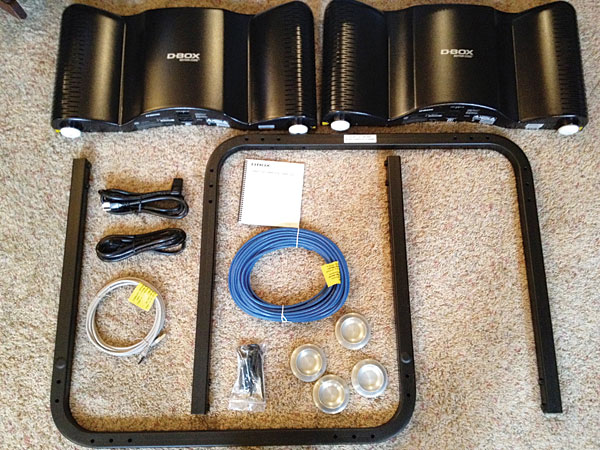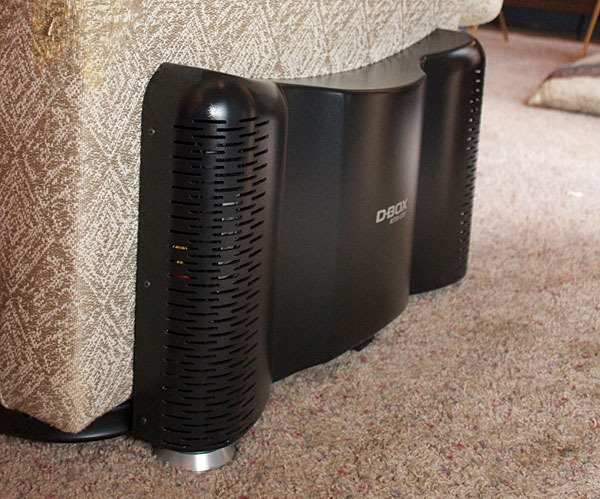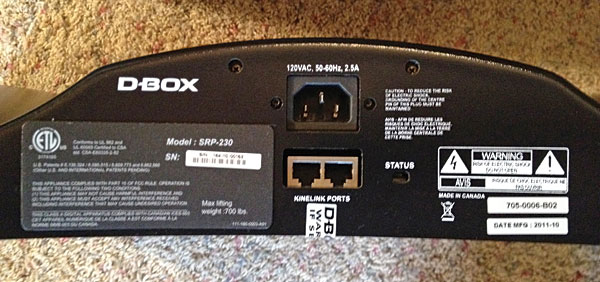D-Box SRP-230 Motion Platform and Standalone Series IV-BD Motion Controller Page 2

Motion Slickness
There are three ways to control a D-Box Motion Platform. If you have a dedicated Windows-based PC in your home theater, you can use its processing power, hard-drive space, and Internet connection with either the two-row-capable MCI-2P ($700) or the four-row-capable MCI-4P ($900) Motion Controllers. For this review, D-Box sent the Standalone Series IV-BD ($4,000) Motion Controller, a self-contained, dedicated computer with a built-in 500 GB hard drive, Blu-ray, and DVD-ROM drive, and Ethernet port. In the case of the Series IV-BD, D-Box’s entire library of motion codes for movies and TV shows is stored on the internal hard drive—and the system can automatically download new motion codes from the Internet as they become available. Updates to the controller’s code library are free for the first year. After that, yearly and four-year subscriptions are available. One Series IV-BD can support up to four platforms or seats.
As with the SRP-230, installation of the Series IV-BD Motion Controller was quick and easy. Besides the power cable, there are only three connections to make: the Cat5 cable running from one of the actuator modules, a digital-audio connection (optical or coaxial) from your BD or DVD player (which is then looped back to the appropriate digital input on your pre-pro or AVR), and a low-level RCA connection from your pre-pro’s or AVR’s subwoofer output (which is then looped through to the subwoofer).

That’s all it takes. Other than fiddling with some of the preference parameters, you’re ready to fire up the system and get some good-old-fashioned virtual reality going.However, you may have noticed a glaring omission in the list of connections—there are no HDMI inputs on any of the D-Box Controllers. They all currently require a Dolby Digital or DTS 5.1-channel signal to be able to identify the movie you are watching and load the correct motion codes. PCM (Pulse Code Modulation), PCM down-conversion, and/or secondary audio option outputs won’t work; your BD/DVD player’s audio-output format has to be set to Dolby Digital or DTS.
D-Box’s Motion Controllers have three modes of operation. The first is F/X Auto, in which the Controller attempts to identify the movie currently playing and, if available, load the motion codes and begin operating the actuators. The second mode, Audio, does not utilize any preprogrammed coding. It works with any analog-audio signal passing through the Controller’s analog-audio input on its way to the subwoofer; the vibrations generated are in direct relation to the incoming audio signal. In a sense, this mode turns the D-Box platform into an elaborate bass shaker for your couch. The third mode, Demo, is for testing and showing off the system. It runs the platform through a variety of preset motions, including a series of vibrations that actually made my couch resonate so much it sounded like a plane taking off.

Not everyone is going to prefer the same degree of motion or vibration, so you can make a couple of parameter adjustments for each of the modes. In Audio mode, the amount of audio gain used to simulate vibration can be raised or lowered from the preset 50 percent to either increase or reduce the intensity of the effects. (Four factory presets—Music, Movie, Game, and Sport—can only be selected via the Series IV-BD remote control, which is a slight complication because D-Box no longer has remote controls available for the Controller.) F/X-Auto mode reproduces the range of motions preprogrammed in the motion code for that movie, but a couple of overall parameters can be changed. Volume, for example, is a standalone adjustment that increases or decreases the intensity of the overall experience. Motion (i.e., movement of waves on a boat) and Vibration (i.e., the texture of a road with gravel or pavement) are linked together and can be adjusted so that one is more prominent than the other.
Artful Dodger
While the design of the actuators and Motion Controller hardware is excellent, none of it would matter without the truly artful work of the motion designers at D-Box who sit in front of their monitors and determine the appropriate range of motion the actuators should create for that particular scene in a movie or TV show. Much like the sound designers who create the most engaging cinematic sound and surround effects, the motion designers at D-Box not only have to take into account the onscreen motion, they also have to consider the emotional tone of the movie at that moment. An action-animation film, such as Speed Racer, can (and should) have over-the-top motion effects, and D-Box’s motion codes re-created just that. There is no doubt that the platform is engaged during any of the racing scenes—and the effects actually caused me to watch the entire movie through to the end for the first time. Real Steel on the other hand, while being an action movie, also has its share of tender moments. The various robotic fights are filled with motion, as you would expect, but it’s also balanced by some very subtle effects. When Charlie (Hugh Jackman) and Max (Dakota Goyo) are in the junkyard, for instance, and Max slides down the hill after the edge of the cliff crumbles under him in the rain, the movement of the platform follows Max’s course. At the end of the scene, however, during the emotional moment when Charlie lifts Max off of the exposed robotic arm that saved the boy’s life, there is no motion in the platform at all—even though there is movement onscreen. Motion, at this point, would detract from the emotion, and kudos to all of the folks at D-Box who understand that motion control is an added element that’s to be used to immerse you in the story, not supplant or overpower it.

I could go on and on about the various movies in which I found the D-Box coding to be spot on, but I’ll just give one more example. In U-571, as the Americans begin their attempt to capture the titular German sub, there’s a clear mix of the general rolling of the waves with the dramatically different and more focused vibration from the machine gun shots and grenade explosions. Later, as a series of depth charges explode to the left and right of the sub, the rumble and rattle of the submarine created in the platform followed the left/right pattern of the exploding charges. When the German destroyer shoots at the captured sub while it’s on the surface to prevent its precious cargo from being arrested, the vibrations simulating the impact of the bullets that rip across the deck onscreen tracked the sound precisely in sync as it passed from the front speakers through to the surrounds. In other words, the bullets felt as if they were hitting the couch itself. It was an effect that no number of surround channels or subwoofers could ever have been able to create.
A Truly Moving Experience
One of the benefits (some would say curse) of writing for Home Theater is that we get to play with a lot of cool and exciting gear that we would otherwise never be able to because we simply couldn’t afford it. For example, I’d just about be willing to give my left testicle for a full-blown, multiroom, Kaleidescape Blu-ray Disc/DVD/CD/media server configuration (that’s compatible with D-Box motion systems, by the way), but as far as I know, the company won’t take a testicle as payment. Because a system like that would easily cost more than the new four-wheel-drive SUV I’m going to be needing soon, the Kaleidescape servers are going to have to wait (unless the company starts accepting body parts soon).

I didn’t ask the people at D-Box if they’d consider taking a nonvital organ in trade for the SRP-230 Motion Platform and Standalone Series IV-BD Motion Controller. (I was afraid that if they said “absolutely!” or “which one?” I’d have a huge dilemma on my hands…er, hand.) Nevertheless, it’s the kind of gear that grows on you the more you use it, until one day, when it’s time to send it back, you suddenly stop returning phone calls and answering your email. Sure, the system has its faults. The lack of a remote control, for instance, is inexcusable—although they tell me they’re working on finding a replacement, so maybe they’ll have one by the time you read this. And, in addition to not accepting audio via an HDMI connection, it won’t work with streaming media. But the fact of the matter is that motion control—when done properly—does as much to engage you with a movie as having a 5.1-channel surround system (and certainly more than 3D). I know that statement may sound heretical, but physical movement is an unmistakable missing dimension of the movie experience that’s virtually impossible to re-create audibly and visually.
I’ve given numerous visitors demonstrations of the D-Box Motion Platform since I’ve been testing it, and it’s one of the only pieces of gear I’ve reviewed in more than a decade that every single person has absolutely raved about after experiencing it. It’s unbelievably good—and unbelievably addicting. Overblown demonstrations at dealers’ showrooms are useful to get your attention, but they don’t even begin to give you an idea of the intense immersion the D-Box system can provide for movies that don’t include much surround, but have an emotional story line. At $12,000, I absolutely cannot afford the D-Box SRP-230 Motion Platform and Standalone Series IV-BD Motion Controller. Maybe you can. But either way, I’d recommend you locate a dealer to try a system out, or find one of the D-Box-equipped commercial theaters. If it’s remotely within your reach, I’ll bet you’ll end up buying one.
Motion control is as amazing today as surround sound was when it was introduced 30-some-odd years ago. It’s truly another dimension in home entertainment—one that we can all aspire to own, and hope that someday the price will allow us to do so. In the meantime, we all owe a debt of thanks to D-Box for being such a pioneering mover and shaker in the art and science of motion control.




























































